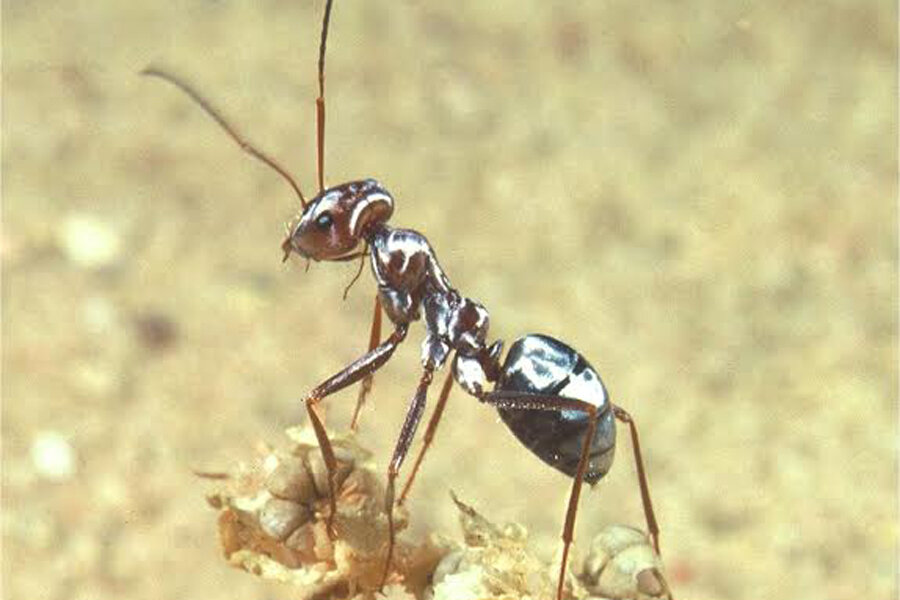Ants are eusocial insects of the family Formicidae and, along with the related wasps and bees, belong to the order Hymenoptera. Ants evolved from vespoid wasp ancestors in the Cretaceous period. More than 13,800 of an estimated total of 22,000 species have been classified. They are easily identified by their geniculate (elbowed) antennae and the distinctive node-like structure that forms their slender waists.
Ants form colonies that range in size from a few dozen individuals often living in small natural cavities to highly organised colonies that may occupy large territories with sizeable nest that consist of millions of individuals or into the hundreds of millions in super colonies. Typical colonies consist of various castes of sterile, wingless females, most of which are workers (ergates), as well as soldiers (dinergates) and other specialised groups. Nearly all ant colonies also have some fertile males called "drones" and one or more fertile females called "queens" (gynes). The colonies are described as superorganisms because the ants appear to operate as a unified entity, collectively working together to support the colony.
Ants have colonised almost every landmass on Earth. The only places lacking indigenous ants are Antarctica and a few remote or inhospitable islands. Ants thrive in moist tropical ecosystems and may exceed the combined biomass of wild birds and mammals. Their success in so many environments has been attributed to their social organisation and their ability to modify habitats, tap resources, and defend themselves. Their long co-evolution with other species has led to mimetic, commensal, parasitic, and mutualistic relationships.
Ant societies have division of labour, communication between individuals, and an ability to solve complex problems. These parallels with human societies have long been an inspiration and subject of study. Many human cultures make use of ants in cuisine, medication, and rites. Some species are valued in their role as biological pest control agents. Their ability to exploit resources may bring ants into conflict with humans, however, as they can damage crops and invade buildings. Some species, such as the red imported fire ant (Solenopsis invicta) of South America, are regarded as invasive species in other parts of the world, establishing themselves in areas where they have been introduced accidentally.
-
Non-native ants are breaking down biogeographic boundaries and homogenizing community assemblages
-
How 16th Century Trade Made Fire Ants an Early Global Invader
Megathreads and spaces to hang out:
- 📀 Come listen to music and Watch movies with your fellow Hexbears nerd, in Cy.tube
- 🔥 Read and talk about a current topics in the News Megathread
- ⚔ Come talk in the New Weekly PoC thread
- ✨ Talk with fellow Trans comrades in the New Weekly Trans thread
- 👊 Share your gains and goals with your comrades in the New Weekly Improvement thread
reminders:
- 💚 You nerds can join specific comms to see posts about all sorts of topics
- 💙 Hexbear’s algorithm prioritizes comments over upbears
- 💜 Sorting by new you nerd
- 🌈 If you ever want to make your own megathread, you can reserve a spot here nerd
- 🐶 Join the unofficial Hexbear-adjacent Mastodon instance toots.matapacos.dog
Links To Resources (Aid and Theory):
Aid:
Theory:

THE ANT GENERAL LIVES
I present the Saharan Silver Ant:
Why are they silver, you ask? Sadly they are not chrome-plated, instead they are covered in silvery hairs that reflect sunlight. This is because the Saharan desert is in fact very hot, like super hot, like hot as hell, extremely very really hot.
They have this really cool lifestyle where they wait until the short period of time when the heat is too much for predatory lizards, but not quite beyond their threshold, and they come rushing out at high speed to collect any critters who croaked in the extreme heat before the lizards re-emerge. They basically live like divers except they dive into hot desert air instead of water.
Their bodies even "hold their breath" in a sense. Most animals release heat-shock proteins in response to heat, but these ants somehow build them up beforehand and get their foraging done while the proteins are still concentrated in their bodies. It also helps that they are maybe the fastest ants in existence. They run so fast that they end up running on 4 legs with their front two in the air like little dinosaurs.
It's also worth mentioning that individuals triangulate their position with the colony and use the sun for navigation. And unlike many species of ant, pretty much the entire colony forages, with only a few staying behind to keep watch. Life is tough for a silver ant.
Ants facts
Have you considered posting ant facts or general bug facts in c/earth or smth? Good post.
I could but I worry my command of bug facts has limits since most of these ant facts I picked up doing research for a book. Maybe though, it would give me an outlet for my larger stockpile of reptile trivia
I keep reading this as the Sarah Silverman Ant while scrolling by